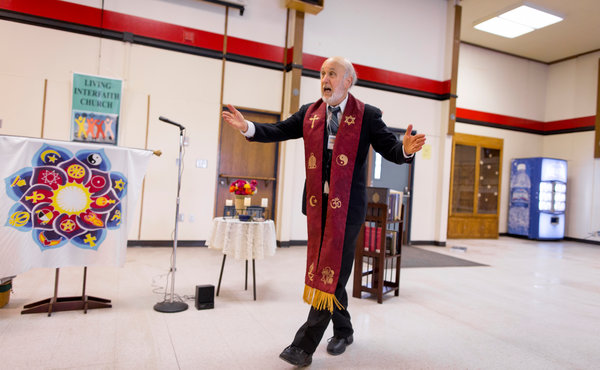Clement Pulaski
Daily Stormer
July 13, 2013

As the New World Order removes the last vestiges of tradition from Western society, certain individuals amuse themselves with the outer symbols of ancient faiths. They uncompromisingly uphold the tenets of political correctness, but dress up their dogma in religious trappings. These men can look you in the eye and say that Christ’s message mandates the acceptance of homosexual marriage, an example of doublethink as outrageous as anything dreamed up by a communist regime. In a recent piece in the New York Times, Jew reporter Samuel G. Freedman lauds the efforts of Jew “pastor” Steven Greenebaum and his Living Interfaith Church, an example of the trend towards humanistic “pan-religion”. During a service at Greenebaum’s church:
the liturgy moved from a poem by the Sufi mystic Rumi to the “passing of the peace” greeting that traced back to early Christianity to a Buddhist responsive reading to an African-American spiritual to a rabbinical song. In other weeks, the service has drawn from Bahai, Shinto, Sikh, Hindu and Wiccan traditions, and from various humanist sources.
When explaining his mission, Greenebaum exhibits the contradictions inherent in the position that “all religions (and non-religions) are equal”:
“Many of our most intractable ills may be laid on the altar of our divisions into ‘them’ and ‘us.’…Such a mind-set allows us to judge others and find them lesser beings. Now, I’m not here to try to convince anyone that there is no such thing as right or wrong. But I am here to say that there is no ‘them.’ And there is no ‘us’ who are somehow superior to them.”
It is clear to any rational person that if good and evil do exist, then it is possible to say that individuals are working either for or against the good. This is a basic belief of any religion. Teaching that those who engage in a particular sin are no different from those who do not will naturally lead to accepting that sin and virtue are not truly opposed. That is not to say, however, that Greenebaum promotes complete anarchy in the sphere of morality. If one looks closely, it emerges that Greenebaum and his followers do hold some moral convictions. The core ideas of their faith are expressed in their Six Fundamental Assumptions. Five of the six assumptions are positive statements about what we should do, and only one of the five tells us what is bad. This lone “thou shalt not” of their religion reads:
Economic, racial, ethnic, religious, gender, sexual orientation and all such divisions have no spiritual relevance, and any hierarchy based on them is both baseless and harmful.
This same basic trick has been used time and again by modernists: absolute moral values do not exist, but racism, sexism, etc., are absolutely evil. The logical fallacy is obvious, and yet this trick has been tragically successful in tearing down the values of the West. Thus it is both sad and predictable that many fail to see through the paper-thin facade of Greenebaum’s infantile “religion” to the nihilistic core of his dogma. In his article Freedman mentions:
fully one-quarter of Americans attend worship services outside their own faiths, according to a 2009 survey by the Pew Research Center. The report attributed that trend to the growth of interfaith marriage and to the influence of Eastern religions and New Age spirituality.
Western man has forgotten how to draw proper boundaries: boundaries in community, nation, thought, and faith. If our enemies are allowed to achieve their goals, the pseudo-religion of Greenebaum will become the only acceptable faith.
 Daily Stormer The Most Censored Publication in History
Daily Stormer The Most Censored Publication in History


